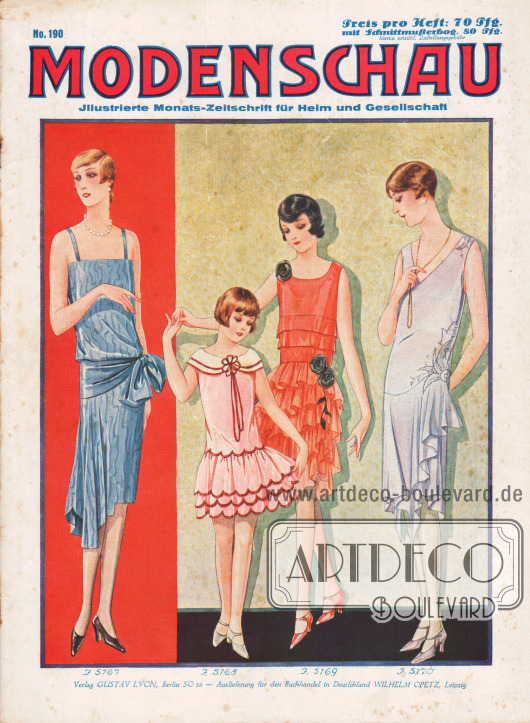|
|
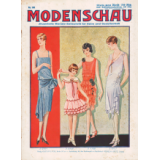
|
Title page or front cover of the German fashion magazine Modenschau (Eng. title: Fashion Show, subtitle: Illustrated Monthly Magazine for Home and Society) no. 190 for October 1928.
Description of the color cover page.
J 5167. Elegant evening dress in water blue moiré with ribbon straps and skirt extended on one side. Solid color waist girdle with bow. Fabric usage: 3 m moiré, 100 cm wide. Pattern size 44 and 48. Price 95 pf.
J 5168. Pink crepe de chine party dress for girls 6—10 years old. Red edging on the scalloped edges. Red trim at white shoulder collar. Rosette. Fabric usage: 2.75 m 100 cm wide. Pattern 75 pf.
J 5169. Youthful dance dress in salmon pink crepe de chine and tulle used for flounce skirt. Wide hems at the waist. Dark corsage flowers. Fabric usage: 1.90 m silk, 1.85 m net lace, each 100 cm wide. Pattern for 14—16 years and size 42. Price 95 pf.
J 5170. Evening dress in pastel purple silk with interestingly pointed skirt and beautiful embroidered motif. Fabric usage: 3.50 m 100 cm wide. Transfer pattern, price 40 pf. Pattern size 44 and 46. Price 95 pf.
Price per copy: 70 pf., with pattern sheet 80 pf., plus local delivery charge.
Publishing house Gustav Lyon, Berlin SO 16 — Distribution for the book trade in Germany Wilhelm Opetz, Leipzig.
Title illustration/title drawing: unknown/unsigned.
|
|
|
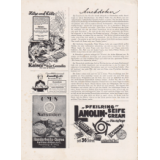
|
Article:
N. N., Anecdotes.
Advertising:
Heat and cold in rapid succession are the worst starting points to colds and subsequent severe suffering. How many professions suffer from the same circumstances. For each such profession, it is necessary to prevent in this way. If you have a cold, you must get rid of your cough and catarrh quickly and safely. For 40 years it has been proven again and again that Kaiser's Brust-Caramellen [Chest Candy] are an excellent and cheap remedy. Take it too and always pay attention to the brand "3 Tannen" ["3 firs"]. In pharmacies, drugstores and where posters visible. Bag 40 pf. Tin 80 pf. Kaiser's Brust-Caramellen with the 3 firs.
Quality mail order Lustig & Co. Dresden-A.1. Rosenthal tableware and coffeeware, including the "Maria" and "Perlrand" ["Perl Edge"] shapes, we supply without surcharge against part payment. 20% down payment, rest 5 monthly rates. We will send you the richly illustrated catalog P 58 free of charge. Drawing/illustration: "KROTOWSKI" (Stephan Krotowski, 1881-1948).
C•M•S Sewing Silks (FABRIK-MARKE SEMPER BENE) Handwork yarns Carl Mez & Soehne A.-G. Freiburg i. B. – Vienna. Founded in 1785.
"PFEILRING" LANOLIN SOAP & CREAM for skin care unsurpassed for 36 years! Drawing/illustration: "S" (unknown signature).
|
|
P. 1 |

|
Title page or cover of the Modenschau (Eng. title: Fashion Show, subtitle: magazine for home and society) no. 190 for October 1928.
Article:
Parsen, P., The Bachelorette and Her Home (by P. Parsen, unknown author).
In the center of the page is a photograph with Hungarian singer and film actress Iréne Ambrus (1904-1990), sitting in an armchair, smiling into the photo camera and holding open in her hands an issue of Modenschau. The caption reads "Every woman gets a man who can sew after Lyon patterns. Iréne Ambrus." Photo: Alexander Binder, Berlin, photographer (1888-1929).
[Parsen, P., The Bachelorette and Her Home.]
"I'm sorry, but I don't rent to ladies!" How often must the bachelorette hear this refusal, sometimes uncharitable, sometimes very polite, but always expressed with equal firmness, when she seeks lodging? Is distrust in moral reliability, are outdated views from past times, where one wanted to see something not quite correct in the single younger lady, the reason for so many ladies renting rooms to accept only gentlemen on principle? In many cases it is indeed one of these reasons, but in many cases it is also the fear of greater demands that the female tenant might make. The "furnished gentleman" is usually less demanding than the professional woman without a home of her own: he is satisfied if the room is kept in order and he is left alone! First of all, ladies have higher demands on cleanliness and comfort, they always ask for a little more help and are more often at home in their free time; they love to prepare a small meal themselves much more than the gentleman, they are, in a word, used to more comfort, more domesticity, because they are always women, in spite of all their economic autonomy and inner independence! One can understand that anyone who has to give up rooms in his home — and how many are there today! — is anxious to have as little trouble as possible with the forced housemate and therefore prefers to choose the gentleman rather than the lady as a tenant. It is not very philanthropic, but man is imperfect and therefore, unfortunately, mostly an egoist. From a purely economic point of view, renting rooms is a business, and one cannot blame the landlords for striving to make this business as profitable as possible — renting rooms is never pleasant! But we want to be fair! Countless bachelorettes have the good fortune to find a comfortable room with kind people, where they are offered more than a shelter, and where in time — if they themselves possess the appropriate qualities — they become housemates in the best sense of the word, whose personal freedom is respected, whose studious work is recognized, and to whom friendly warmth is extended. But even then they lack something: they have an apartment — but no home. Always, for all the harmony, the feeling rings through: "You are here with strangers, you are an intruder whom one was forced to take in only out of the necessity of the time; this furniture, these pictures, this bed is left to you only for use and will always remain alien to you!" The man who is less finely organized in such matters will hardly feel this dichotomy: the majority of male bachelors have not known it any other way since time immemorial than to have to lead the nomadic existence of the "furnished gentleman" until the moment of marriage. But the young and older girls, who today stand upright and brave beside the men in their profession, come from the comfortable, even if often simple security of a parental home, … [Continued on page 2.]
[Page] 1
|
|
P. 2 |
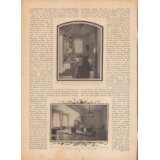
|
Article:
Parsen, P., The Bachelorette and Her Home (by P. Parsen, unknown author).
There are two photographs printed on the page. The top photo shows a kitchen and the bottom shows a spacious reception room. The captions read "The bachelorette's cooking area (home of postal and telegraph officials). Photo: Fernstaedt" and "The stylish reception room of the student bachelorettes in the Victoria Study House. Photo: Fernstaedt."
Photos: Carl or Karl Fernstaedt, photographer (1894-1978).
[Parsen, P., The Bachelorette and Her Home.]
[Continued from page 1] … which has always been a heart-strengthening support for them — they need a real home more than the man. And so, within the framework of the great problem of "housing shortage," the question of the bachelorette's home becomes a partial problem, which we must all the more avoid, since all the laws against the housing shortage today always provide only — and that too in a completely inadequate framework — for the married. The question is by no means acute only since the war; it always has been, and in our time it has only become more urgent because of the substantially higher number of working unmarried women. And that is why the attempts to find a solution date back to the time before the war. Let us first leave aside the question of who could raise the means to create a real home for the bachelorette, and first consider what this home would have to be like. The basic idea of the term "home" is always the family, but this is missing for the bachelorette. However, it can be replaced — even if not completely — by the union with like-minded people, people striving for the same things, members of the same profession or simply with other bachelorettes of approximately the same social stratification. And first of all for the leisure hours! This brings us to the form of the club based on the English model, as we find it in the German Lyceum Club in Berlin. Intellectual and artistic women find here on certain days the possibility of mutual discussion, supportive and entertaining lectures, but also at any time the opportunity to gain rest and stimulation in the social rooms and to get closer to each other on a human level. Quite similar to the English clubs, some rooms, unfortunately far too few, are also set aside for members. The various evening and Sunday homes are based on similar ideas, all of which want to and can only provide for leisure time. But they are only a temporary home — far from being a real home! Only when accommodation, catering and collegial or social connection can be united in one place, we can really speak of the home of the bachelorette. Here there are now different ways and forms! Let us take, for example, the home for single women of the "Soziale Arbeitsgemeinschaft e. V." ["Social Working Community Association"], which was opened in Berlin shortly before the war. Here the club idea — though only for men — is already further developed: fixed house rules, uniformly furnished living rooms, communal dining and social rooms. Something similar, but in a more comfortable setting and tailored to the very special needs of young girls studying, is offered by the Victoria-Studienhaus [Study House], created from a foundation by Ottilie von Hansemann, in Berlin-Charlottenburg. Similar student clubs — if you want to call them this way — are in the making. But such club-like institutions are only transitions; they must and will always have something template-like, hotel-like, which deprives them of the intimate charm of the very personal of a permanent home. But this is what matters, because the modern bachelorette is not just a woman preparing for her career, but a woman who is already firmly established in her professional life! But it is precisely this woman who wants more than a room to sleep and work in and the possibility of taking her meals in a common dining room; she needs her own home. Thus, the Association of German Postal and Telegraph Officers has built very comfortable houses in Berlin, built according to the most modern principles, which consist of one-room apartments, each with a balcony and a sleeping niche and kitchenette to meet all needs. Indisputably, this is almost the ideal of a bachelorette home! But not every bachelorette is a culinary artist or has the time and inclination to prepare her own meals, but still wants to be able to have her meal within her own four walls. So the possibility must be given to obtain from a central kitchen, if necessary, the ready meals, which are then only warmed on the cooking place of the apartment. Even the reheating could be made superfluous: today there are enough heat-retaining transport containers and practical transport equipment to bring the meals… (conclusion page 11).
[Page] 2
|
|
P. 3 |
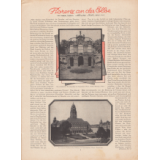
|
Article:
Sell, Anita, Florence on the Elbe (by Anita Sell, unknown author).
In the center of the article are two photographs. The captions are "The delightful baroque pavilion in the Zwingerhof. Photo: Techno-Photogr. Archiv" and "In newer Dresden: The city hall with Friedrichsring. Photo: Transocean."
Photos: Techno-Photographic Archive; Transocean Agency.
[Sell, Anita, Florence on the Elbe.]
"I was overcome by that serenity that Dresden, and only Dresden, can give on a beautiful spring or autumn morning. The city then bestows a delightful lightness and carefree cheerfulness." The person who wrote this is one of the greatest German poets of our time: Gerhart Hauptmann. Dresden's essence and spirit, Dresden's meaning for the joy-seeking wanderer is thus wonderfully specified. At the same time, however, it is clear to everyone between the lines how close the connection is between Florence, that gracefully playful elegant city of the Medici, and the city of Augustus the Strong. Only: that Florence on the Arno is today partly a noisy, average Italian city, partly a museum in which memories of past glories are carefully cherished and shown to the astonished strangers. Our German Florence on the Elbe, however, is alive: its wonderful baroque buildings are surrounded by the most modern life; but at the same time, there is always something festive, joyfully happy, that is, something special, in this up and down of the big city; one can feel it better than to say: the spirit of a better, bygone Italy can be felt here, Germanized and deepened, refined and modernized, more powerfully than in the non-festive modern Florence! One could perhaps say: German feeling and thinking, creating and building on a classical Italian basis. In any case, and this is the decisive point, Dresden is one of the most graceful and yet most impressive German cities! One has to cross the leisurely flowing Elbe on the Friedrich-August-Bridge from the Neustadt to grasp the heart of Dresden at once! From the arrival side, the magnificent main station in the old town, the most delicious part of the city of Dresden develops only gradually and brings details to special advantage, but deprives you of the monumental impression that you get from the Elbe side. One is used to the sight of so many important squares: the solemn regularity of massive buildings seems imposing, but still a little monotonous! Here, however, there is an almost funny disorder: The palace square with the double building of the palace and the court church, crosswise to it the Wallot building of the Staendehaus [House of the Estates], has a completely irregular form, so that the buildings push over each other like a backdrop; the theater square lying close to it, however, is so airy and light through the wide space in between and so gracefully structured by the Zwinger, which closes it off, that one can really take great pleasure in the clever architects of the Saxon electors and kings! The most beautiful view can be enjoyed from the "balcony of Europe," as master Baedecker called the famous terrace of Bruehl. Then the Frauenkirche also demands our attention, that church with the famous stone dome, whose load-bearing capacity was greatly doubted at the time of construction, but which nevertheless bravely withstood severe hardship and danger: old Fritzen's cannons tried for three days to drive down the observers presumed to be there — but the dome held out! And when one looks forward, from the parapet of the terrace up and down to the wide Elbe river, then one realizes how ingenious the builder, that daring, unscrupulous intriguer and most powerful minister of Saxony, that schemer and merciless tax collector of his prince, must have been: he could not have chosen a better place for this building. One forgives him much of what history reports of him, standing up here! Here again one has the parallel to the real Florence: the powerful there were not exactly father of their people — but they knew how to use the hard taxes well, by decorating their city masterfully, by knowing how to promote arts and sciences. Saxony's electors, at the same time… (continued on page 7).
[Page] 3
|
|
P. 4 |

|
Article:
Hecht, Dr. Robert, India's Women's World (by Dr. Robert Hecht, unknown author).
Two photographs are printed on the page. The captions read "Princess Seeta Dewis [or Sita Devi, née Renee Smith, Indian-English silent film actress, 1912-1983] a famous Hindustani beauty," and "Ladies of Hindustani grand society at a garden party." Photos: unknown/unsigned.
[Hecht, Dr. Robert, India's Women's World.]
If in all Asian countries of world importance, the women's movement has been able to establish itself in the last decade with a speed that would have seemed quite improbable before, one huge area has remained quite untouched by it: India. China, the country of three thousand years of culture, has not only cut many old braids, but has also cut the hair of the women short and entrusted itself with temperament to the modern intellectual currents. India, however, remains more or less in the old state and wants little to do with a change in the position of the sexes. But China is a unity, while India suffers from the evil of social and religious disunity. Three hundred and fifty million people live in this largest English colony, which appears to the West, who knows it mostly from novels written by people who stayed at home and from fantastic films, as a magic land. But the only magic of India is its pilgrimage cities, while the rest of the country, one of the largest arable areas on earth, is of as much sobriety as poverty. The sharp religious division of the inhabitants into Hindu and Mohammedan contributes even more to the separation of the individual classes than the extraordinary linguistic fragmentation, which spans a hundred languages with even more dialects. — When we speak of Indians, we usually think of Hindus, who are at the head of the population in terms of numbers, but this religious stratification includes others than the main Indo-European population, but an exact enumeration of the splinter tribes would lead too far. The Hindus are divided into those well-known castes which, the longer they exist, prove to be a serious stumbling block to any development. From the fact that these castes have different values, and that no one can rise from a lower caste to a higher one, nay, that in case of gross offence he simply loses his caste and becomes a pariah, arises the difficulty of making social changes on a large scale. Women, like men, are also tied to caste and can only ever be married by a man from the same caste. This organization, which is widespread throughout the country, therefore does not bring social elevation through marriage to any woman. Little emphasis is placed on the education of girls; schooling considers boys first, since Hinduism emphasizes the absolute principle of male domination. Child marriage is still prevalent. At a very young age, children are married off, but they remain in their parents' home until they become men. In general, one must always keep in mind with oriental peoples that they do not know such an individual life as we do, but that the family as a whole plays the main role. Even the married sons remain for some time in the house of their parents, and the mother-in-law rules over the individual daughters-in-law. It is a strict custom that the widow does not marry after the death of the husband. Because of these early marriages, India has become the land of widows, whose situation is very bad because a widow is considered a being who has lost the right to live. Of course, the infamous widow burning existed only on a small scale in the past and occurred mostly in noble families when the spouses had lived together for many years. The majority of Indian women are so occupied by the care of daily life that they have no time left for spiritual matters, apart from the necessary religious exercises. Only in strata whose lives are economically secure do women take some part in public life, visiting cinemas and dissipating themselves in their own way. At least, all observe some restraint from the public. There is no veiling, but one will hardly ever meet a distinguished Indian woman on the street; it is not part of good manners. The houses of the rich Indians, where English governesses come today, are surrounded by splendid evergreen gardens, with cool courtyards where people retreat from the heat of the day. The ladies visit each other, give teas in their gardens, dinners at which, however, they keep strictly to themselves. These visits invariably take place in the carriage; no Indian lady would ever set foot in the street. It is the custom in all countries that the way of life given by the ladies of the first circles is exemplary for other social classes. Since the distinguished Indian women still set the example of restraint, the coming forward of a Hindu woman to the public is simply impossible. The family would know how to prevent it by all means if this will should suddenly appear. — Now our… (Conclusion page 11).
[Page] 4
|
|
P. 5 |
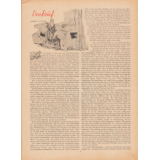
|
Article:
Lothar, Erwin, The Letter (by Erwin Lothar, unknown author).
The drawing in the upper left corner shows a man kneeling in front of a woman. The scene takes place in a living room.
Drawing/illustration: Ernst Ludwig Kretschmann (1897-1941).
[Page] 5
|
|
P. 6 |
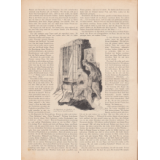
|
Article:
Lothar, Erwin, The Letter (by Erwin Lothar, unknown author).
The drawing in the center of the page shows a young woman sitting at a small ladies' desk. Behind her stands a middle-aged man. A glass door to the balcony of the study has probably been cracked open by a breeze. The caption reads "At the desk, in the moonlight, sat my wife, in her shroud…".
Drawing/illustration: Ernst Ludwig Kretschmann (1897-1941).
[Page] 6
|
|
P. 7 |
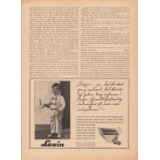
|
Article:
Lothar, Erwin, The Letter (by Erwin Lothar, unknown author);
Sell, Anita, Florence on the Elbe (by Anita Sell, unknown author).
[Sell, Anita, Florence on the Elbe.]
(Conclusion) [Continued from page 3] … Poland's kings for a time, were also magnificence-loving lords: it fits everything we know about August the Strong that he had the most lively building in Dresden, the Zwinger, built, just as the "organ race" fits his son and successor August III: Master Sebastian Bach was to measure his art against that of the famous Frenchman Marchand on the organ of the Frauenkirche in December 1736. But when the latter heard Bach testing the organ the day before, he preferred to disappear by night and fog! They were not quite as rich, not quite as cultured as the Florentine Medici, the rulers of Saxony — but they knew how to live well and loved art and science. The beginning of the famous picture gallery can also be traced back to the two Polish kings on Saxony's throne, August II and III, … [Continued on page 8].
Advertising:
"Laxin —, yes, that's something completely different, I could take that every day! Laxin tastes great and afterwards you feel like you've been reborn!" —
Children usually have a violent aversion to nasty-tasting laxatives. Give your child Laxin, whose pleasant fruit taste all children love and which works mildly and safely, your child will thank you by being healthy and cheerful. *
The interesting brochure about "Laxin" free of charge from Lingner-Werke [Linger Works] in Dresden. Laxin. Photo: unknown/unsigned.
[Page] 7
|
|
P. 8 |
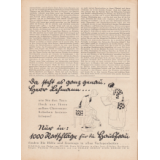
|
Article:
Sell, Anita, Florence on the Elbe (by Anita Sell, unknown author).
[Sell, Anita, Florence on the Elbe.]
[Continued from page 7] … and it was Count Bruehl's agent, Carlo Giovanni, who brought Raphael's wonderful Sistine Madonna from the monastery of San Sisto in Piacenza to Dresden for twenty thousand ducats, while nine years earlier a hundred of the most precious paintings by great Italian masters were brought to Dresden from Venice in one fell swoop, a selection of this sublime art that had never existed in Germany before. Perhaps one has not always done justice to these most splendor-loving of the Saxon princes: history reports of the Medici that they were also said to have considerable mercantile talents — in the end, another feeling than just the joy of splendor and pomp and spending money guided the actions of the rulers of Florence on the Elbe? It is reported that at their court there was a huge influx of foreigners from all countries; foreigners, however, bring money into the country and take local products in return, in this case products of the highly famous Meissen porcelain manufacturer and of the artistry of Saxon lace weavers. Certainly, in those days Dresden's hostels and inns did not have to complain about a lack of guests any more than they do nowadays. And so, behind all the fun, colorful, exuberant festivities of rococo Dresden, there may have been a very real desire to attract and increase tourism? Then Augustus the Strong would have been, so to speak, the founder of Dresden tourism, of this enormous influx from all over the world, which has become an important source of income for today's Dresden! Dresden as a tourist city — that is a chapter in itself: there are foreigners who forego a visit to the imperial capital, but by no means pass Dresden by, and there are foreigners who spend weeks and months, whole years here, especially to pursue musical studies. This, too, is a legacy of the Augustan era: music has been the soul of Dresden, the music of sound, as it still resounds today from the magnificent Dresden opera and was created by the church chapel masters of the Hofkirche: names such as Weber, Marschner and Wagner can be heard in their ranks! Music, however, also of the word, which a Koerner and a Schiller, closely connected to the family of the freedom poet, formed in the Loschwitz garden cottage. Yes, there is the noblest artistic tradition in this city on the Elbe and therefore again: it is the German Florence! But even there, the nourishing mothers of industry and commerce were never forgotten above the queen of art: next to Hamburg, Dresden is the most important trans-shipment center on the Elbe, and its Alberthafen is a hive of activity. At the same time, however — and this must not be forgotten above all the cheerful beauty of the city if one wants to fully appreciate its importance — it is a very important industrial city: the cigarette and chocolate industries have their most important centers here in all of Germany, along with straw weaving, artificial flower and feather jewelry production. (Doesn't it fit the character of the city perfectly that these industries, which serve the cheerful enjoyment of life, have their headquarters here?) This again attracts a rich stream of tourists to Dresden and adds to the international image of metropolitan life on its wide, beautiful streets. But when in summer the stream of travelers pushes towards the magnificent Saxon Switzerland and the Bohemian spas, Dresden has another strong magnet to bring them to at least a short stay: the "Jahresschau Deutscher Arbeit" ["Annual Show of German Work"]! For the past six years, it has been held every summer in the Great Garden, this exemplarily beautiful giant park, which is so large that even the vast expanse of the exhibition takes up only a part of it. It is a nice contrast, when one has first looked at the often bizarre works of art of past times in the quiet twilight of the Gruenes Gewoelbe [Green Vault] in the palace, toys like those once collected by princes in the Kunstkammer [Art Chamber], and then wanders out to the show of the year 1928: it is in the service of technology, that mighty force, which governs our life and made enormous powers subject to the human spirit. And that is more than the real Florence can say of itself today: in Dresden, the high past does not live next to the everyday present, but strong, German life and striving within the framework of genuine joie de vivre! High art, the liveliest creativity of the liveliest present time and an enchantingly beautiful landscape — three magnets draw the wanderer to Dresden and bind him to this German Florence with delicious power. One always thinks back to it with longing, once one got to know it!
Advertising:
It's right there, Mr. Lehmann… how to get the tar stain out of your yellow glazed kid shoes! Only in: 1000 Ratschlaege fuer die Hausfrau [1000 Advices for the Housewife] you will find help and ways out in all embarrassments… Available at the price of RM 1.80, postage 20 pfennigs in all Lyon sales offices, bookstores, Wertheim department stores and from the PUBLISHER GUSTAV LYON, BERLIN SO 16. Drawing/illustration: "BOHT" (Hans Boht, 1897-1977).
[Page] 8
|



